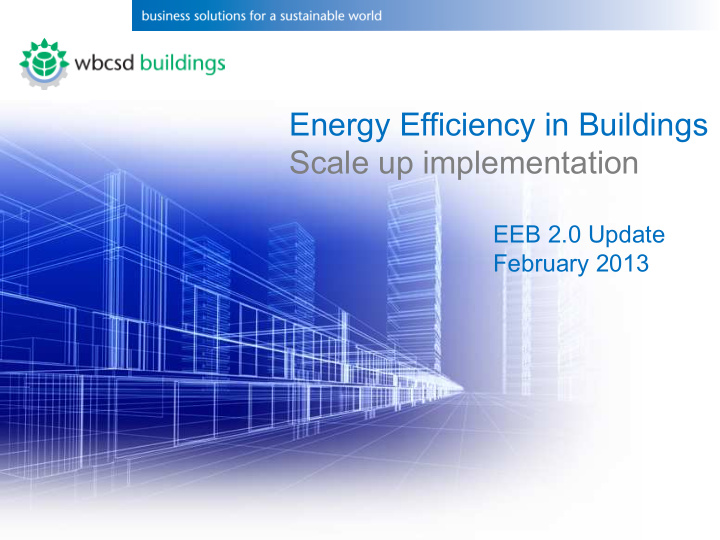



Energy Efficiency in Buildings Scale up implementation EEB 2.0 Update February 2013 1
Why EEB? Buildings are Largest Consumers Buildings are the “invisible” large consumers of energy and emitters of CO2 Source: IEA “Worldwide Trends in Energy Use and Efficiency”, (2008) 2
Why EEB? A Large Business Opportunity Developing (~$1.6T) Existing (~$1T ) 3
The First EEB Project A world where buildings consume zero net energy “Transforming the Market” EEB “Facts & Trends” report Manifesto: 118 report Model Qualitative & Quantitative Signatories to analysis Workshops, Forums, Conferences date Project launch 2006 | 2007 | 2008 | 2009 | 2010 4
“Transforming the Market” stated: “ … At energy prices proportional to US$ 60 per barrel, building energy efficiency measures totaling $ 150bn annually * will reduce related energy use by 40% with a discounted payback period of 5 years. An additional 150bn US$ investment will reduce energy use by further 12% with payback periods of 5-10 years … ” … but change is not happening … * in 6 markets studied (Brazil, China, Europe, India, Japan, and the US) 5
Why a new EEB project (EEB 2.0)? EEB 2.0’s Ambition is simple but bold: To Trigger Motivation for Change ! 6
EEB 2.0: Objective To Unlock financially viable energy efficiency investments that today are not being realized mostly because of non-technical (i.e. financial, regulatory, organizational) barriers . How? By analyzing the decision-making process for energy efficiency measures we can identify the key barriers and develop recommendations how to overcome them. Deliverable: We expect to develop a process that is replicable and scalable across different building portfolios. 7
EEB 2 Decision Makers A Decision Maker (DM) owns or manages a building portfolio*: * Examples are for illustration only, no selection has been made, no one has been approached Owner / Investor ¡ Tenant ¡ Housing Single family Public sector (e.g. French Office HLM) Multi family Private sector (e.g. AXA) Institutional investor (e.g. CALPERS, Pension Denmark) Private sector portfolio /real estate developer Global occupier (e.g. Office (e.g. Prudential, La Française) Deutsche Bank) Corporation (e.g. Siemens) Public sector portfolio (e.g. City of Paris, US GSA) Corporation (e.g. Marriott) Hotels Franchisor (e.g. Hilton) Investor (e.g. Sonae Sierra) Franchisee (e.g. H&M) Corporation (e.g. WalMart) Individual stores Retail Franchisor (e.g. 7 Eleven) Education Public sector (e.g. Univ. South Carolina, Paris schools) Private sector (e.g. Oxford Univ., Infosys) Warehouse Corporation (e.g. Fedex, TNT) 8
EEB 2 will work with Decision Makers DM and their Implementation Network • A DM works with a wide and diverse group of players that may include agents, owners, building users, designers and financiers. Collateral • Stakeholders in his network have benefits influence on or are impacted by DM decisions on energy efficiency measures • Decisions bring also collateral benefits By analyzing the decision-making process for energy efficiency measures we can identify the key barriers and develop recommendations how to overcome them. 9
Decision Makers Engagements The Engagement Process & Key Outcome Confirm stakeholder network and form Initial contact and expert group assessment of Analysis & Scenario issues at stake modeling Dialogue with DM and network Decision Maker DM commits to ambitious Implementation Plan EE plan Engage authorities (local/ national to secure policy commitments Key Outcome DM commits to launching and implementing a project within the EEB framework, 10 with the aim of developing energy-efficient solutions through partnership with all stakeholders involved
How to scale up? By documenting financially viable, replicable and scalable solutions in the decision-making process … for the different market segments DMs represent … disseminating these solutions through the EEB members and partner organizations Ambition: Secure commitments from a wide range of market actors 11
EEB 2.0 Members and Partners Co-chairs Members Membership remains open for up to 9 more companies Partners World Green Building Council 12
Project governance • 3-Year Project (2013-15) driven by annual plan and objectives • Core Group between 10 and 15 • 2-3 co-chairs (Lafarge and UTC, to date) • Core Group Sr. Exec oversee project at Co-Chair invitation • Assurance Group guides project quality • Agreed project fees to cover project costs • All members commit in-kind resources • Company experts to be reimbursed, pro-rata , allowance for external consultants • Partners leverage skills and networks • Governance document formalizes guidelines and decision making rules and structure for key partnerships 13
EEB 2 Timeline: 2012-2016+ Internal ¡Survey ¡ Learning ¡ engagements ¡ Case ¡Study ¡ Reports ¡ DM ¡SelecGon ¡ DM ¡8-‑10 ¡ DM ¡1 ¡ Gain ¡DM ¡Commitments ¡ Project ¡Kick-‑off ¡(Jan ¡‘13) ¡ SE ¡Review ¡ SE ¡Review ¡ SE ¡Review ¡ Phase ¡0 ¡ 2015 2012 2014 2016 2013 Assurance ¡ Assurance ¡ Assurance ¡ Group ¡ Group ¡ Group ¡ QualificaGon ¡of ¡Engagement ¡Process ¡ ¡ 14
Project Work Plan June 2013 to Dec 2015 1 st Half 2013 From 1 st Half 2014 Phase 1 Phase 2 Phase 3 Understand Build and Test Deploy DMs’ Needs Value Proposition Get commitments Internal Survey : “Beta” Test (June-Aug) with EEB 2 company 1 DM engagement per experts to understand quarter key barriers - “Deep dives”/case studies Learning engagements: - Dos and Don’ts San Francisco (ULI) - Replicability Infosys, India Decision Maker selection Meeting to share findings of survey Promote EEB 2 process, leveraging Partner Organizations and the BCSDs 15
Why should you join EEB 2.0? Leverage Project Investments – Leverage against a company’s level of planned investment – Positioning for actual building projects with committed owners/ investors Business Relationships and Network – Develop valuable insights and relationships from Decision-Maker and Implementation Network engagements • Impact on future product and service offerings Learn from Others – Diverse environment of learning for EEB outside of a company’s core area of expertise Brand Leadership Visibility and Position – Valuable visibility in global and local markets – Increased brand or corporate identity with EEB 2.0 16
Roland Hunziker Philippe Fonta EEB Project Director WBCSD Managing Director hunziker@wbcsd.org fonta@wbcsd.org +41 22 839 31 84 +41 22 839 31 04 17
Recommend
More recommend